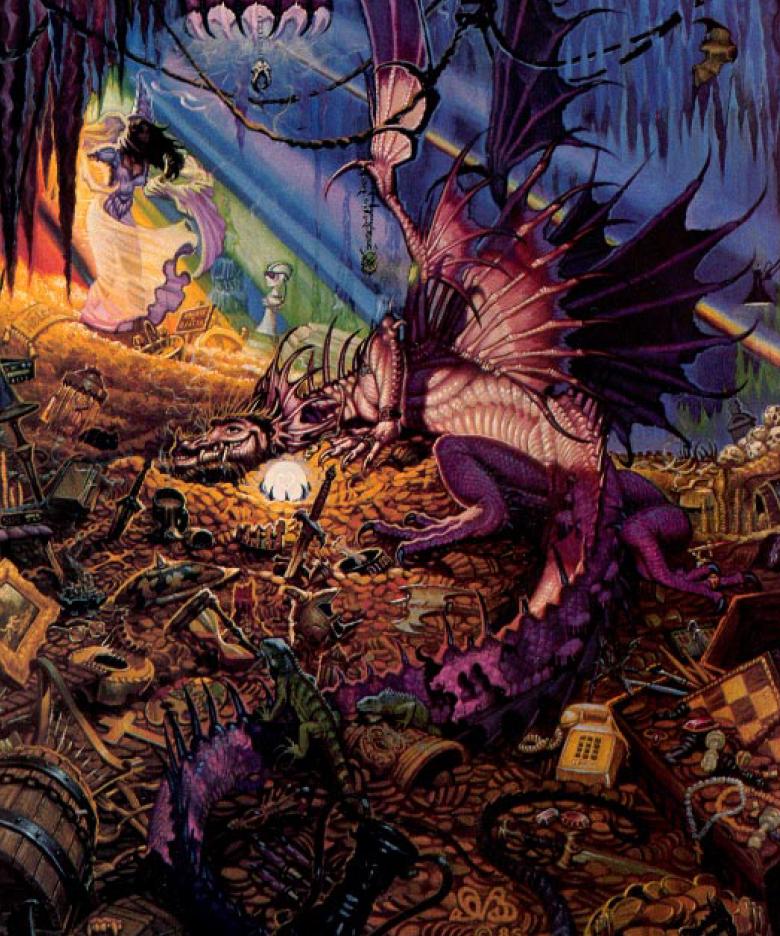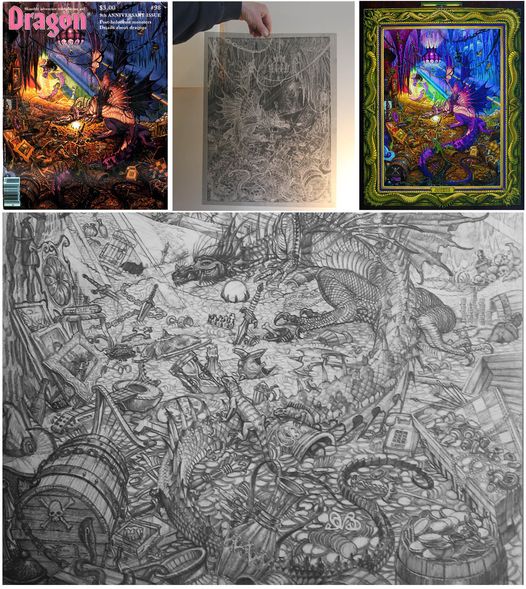

| Dragon hoards | Dragon teeth | Dragon damage revised | The dragons of Krynn | Creative magic items |
| Detailing a campaign world | - | Shops | - | Dragon |
THE FORUM
This letter, confusingly enough, is in reply to
Richard Silva's reply (#103) to Frank Mentzer's <link>
letter back in #101. As you will recall, Mr. Mentzer
's letter stated that the dragons in the new
D&D® game system were a challenge even to
25th-level PCs, while Mr. Silva's
reply denied it. Both writers used the same melee
as an example, and I will do the same. Part of
this reply is based on a letter from Dan Fejes <link>
(#102) which pointed out that magick items must
save vs. attack forms like everything else.
The 7 PCs with ?+5 everything
-- are heading for a red dragon's
lair. But the
dragon finds them first, swoops down in a surprise
attack, and flies off with a fighter, the thief,
and the magic-user. So far, so good. From then
on, here?s what happens.
In the first place, a magic-user caught in the
jaws of a dragon will not be able to cast any kind
of spell. Not only will he not have free movement,
but the shock and pain will probably keep
him from concentrating. This would last a short
time after he is dropped (until it?s too late to save
himself). The magic-user and fighter are killed
when the dragon drops its prey. The thief, with
his ring of feather falling, survives ? but, fighting
alone against a huge ancient red dragon,
won?t last more than a round or two in melee
(why waste your breath on one puny thief?).
Now the dragon flies over the ridge again, to
find the survivors on the ground, who will either
be retreating or walking around the ridge after
the dragon. (If the dragon comes back while they
have their hands full climbing the ridge, the fight
will end in a hurry!) Swooping down again, the
dragon breathes on the entire party. Its members
take half damage from the flames because of their
protective rings, but the cost is high. All the soft
metal rings fail their saving throws vs. magical
fire and melt. The +5 bows of the fighters are
incinerated (making their +5 arrows useless), as
is one cleric?s staff of withering. In addition, one
poor fighter even sees his +5 plate mail melt
away, stripping him down to AC 10. (Since the
fighters in the example were using two-handed
swords, they couldn?t have used shields.)
On to the next round. As soon as the fiery
assault is over, the fighters drink their potions of
storm giant strength, expecting an imminent
melee. Alas, it is a fatal miscalculation on their
part. This dragon, having spent part of his treasure
on an issue of DRAGON® #98, has read the
dragon articles in it, including the bit about
sneaky tricks. So he flies a short distance away,
picks up two boulders, comes back, and proceeds
to play B-17 Over Berlin with the party. The
boulders strike as catapult missiles, and the
dragon?s supply of them is practically limitless. So
the characters suffer a steady bombardment for a
while. This tactic could finish off the party by
itself, but the dragon eventually wearies of the
sport and comes down again.
By this time the unarmored fighter is dead, and
his armored companion is down to 40 hp. The
two clerics are more or less intact, but only at the
cost of expending all of their healing spells on
themselves. The dragon breathes again as it
comes down, killing the fighter and reducing the
clerics to a handful of hit points apiece. He lands
on top of the cleric who is still armed and crushes
her before she can use her mace +4 and gauntlets
of ogre power. One good bite finishes off the
other cleric, and the battle is over.
This scenario is rather unrealistic in one respect
? an intelligent beast like the dragon would
be pickier in its initial selection of victims, assuming
it had observed them for some time. The
example also made no allowance for the possibility
that the dragon was a spell-user. So now, an
alternate scenario.
After having watched the party for some time,
the dragon turns invisible before attacking to gain
complete surprise (not even a 25th-level magicuser
can keep detect invisibility going all the
time). Carefully selecting his initial victims, he
picks up the magic-user (again!) and the two
clerics, flying over the ridge before dropping
them. As before, being tightly held prevents spellcasting,
and with their arms pinned to their sides,
the clerics can?t even use their weapons. (The
gauntlets only affect the hands, so the female
cleric can?t use their power to help her break free
? and where would she go if she did?) Everyone
dies when dropped this time, and the dead clerics
certainly can?t resurrect themselves.
The dragon returns, invisible again. Now he
pops into sight as he breathes on the party. As
before, the bows and rings fail their saves, this
time including the thief's ring. Again the fighters
drink their potions anticipating melee, and again
the dragon stays out of reach and drops boulders
on them. The party is badly battered; no one
dies, but no one is healed, and soon everyone is
down to 40 hit points each.
Now for the final round. Still flying out of
reach of any attack the party can muster, the
dragon belches forth his fire again. Three characters
die; the survivor is picked up in the dragon?s
jaws by a swooping attack just as the fire dies
down, carried five hundred feet in the air, and
dropped to his death.
These two scenarios show that the dragon is an
inevitable victor against the party, given the
circumstances of the encounter and a show of
intelligence on the part of the dragon. He would
know all his advantages, and would pick out the
most dangerous opponents for special treatment.
(In the case of the clerics, their arsenal of all blunt
weapons is a dead giveaway.) So the great wyrm
is triumphant yet again, DMs can rejoice in the
fact that the dragon is indeed a challenge to highlevel
characters, environmentalists can be glad
that a creature of Nature was not slaughtered,
and everyone lives happily ever after ? except
the thief, the magic-user, two clerics, and three
fighters.
Gregory W. Detwiler
Williamsburg, Pa.
(Dragon #105)
